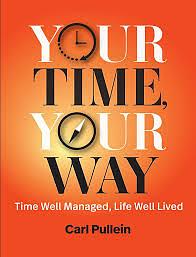Your Time, Your Way by Carl Pullein

I heard of Carl Pullein on a couple of blog posts on EllaneW.com. I follow her blog for tips on all sorts of things, especially using plain text. I learned what I needed to get started, but after I use his method for awhile, I want to reread sections of the book.
Areas of Focus
An important part of this system is to first identify Areas of Focus and make a short list of goals or types of tasks that you feel are needed to move forward in each area of focus. Doing this first helps you decide what tasks are most important to you. Being retired my main areas are Personal Development, Relationships, Health and Fitness, and Spirituality.
Programs
Three programs needed for this system: Calendar, Task Manager, and Notes. Programs alone are not the solution to the problem, so Pullein recommends not spending a lot of time finding the best programs, especially if you already have ones that you know how to use. The emphasis is the information that you put into each of these programs–the thinking you do up front to decide on the tasks and when you’ll do them.
What lit up for me
There is a lot of info in this book, but the main points for me were:
- Time Blocks: Separate your task list into time blocks (This week, Next week, This month, Next month, Long term)
- Consistently plan your upcoming week. It takes 30 minutes and is easier because the tasks are already separated into those time blocks. Reviewing them and moving them around is pretty fast. These are the tasks that go in “This Week” list or folder. Think of what you want to do in the whole week, not in each individual day.
- At the end of the day plan your next day. 10-15 minute process picking from those in “This week” and anything that came in during the day that needs doing.
- Block time in the calendar and do the tasks involved during the allotted time.
Happy outcome
The process of doing is then to see what time it is, look at the calendar for what is to be done at this time, and select the task that pertains to that project or sort of task. This has helped me at least start doing something and starting usually is enough. It seemed that the hardest part was getting past figuring out what to do from a long task list. This process narrows the choice down. The thinking about it has been done in advance, so I’m motivated to get into doing it.
Thinking in terms of tasks for the week takes away the burden to finish everything planned for the day. I’m finding a lot more “Done” tasks at the end of the week than I used to have.
Practice and try more later
Yes, this book is packed, but it seems simple and sensible. It puts the person at the helm and shows how some thinking up front makes the doing of what is important more likely. The author encourages the reader to get started with the basics. I feel like I jumped into the process, got some good results and will find the book helpful as I go along and implement more of his advice in the future.